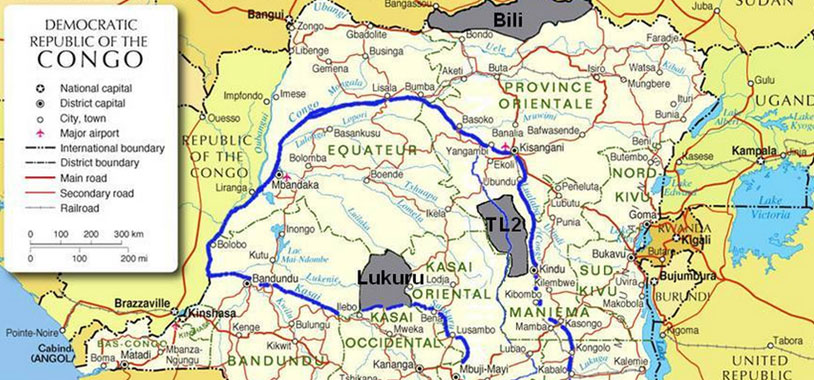Of all Africa’s elephants, those that inhabit the forests of Central Africa have been hardest hit by the current surge in ivory poaching. Some 62 per cent of forest elephants are estimated to have been lost in the last decade. Defending the few remaining areas where they thrive – and securing new areas for their dispersal – are high priorities for the Elephant Crisis Fund.
The Tshuapa-Lomani-Lualaba (TL2) landscape in the Democratic Republic of Congo has a surface area of approximately 60,000 km2 drained by the Lomami, Tshuapa, and Lualaba River basins, and is one area where hope exists for forest elephants. This is to a large degree due to the presence of the Lukuru Foundation – and two of their founders John & Terese Hart – which has been working in the area since 2007.
ECF funding provided support for elephant conservation initiatives in two sectors of the TL2 landscape in central DRC, home to an estimated 670 elephants in central DRC. According to the Lukuru Foundation, without ECF support these activities could not have been maintained during a critical period.
Holding the line
In 2008 poaching pressure began to increase. Guards from another nearby national park were drafted in as reinforcements but proved ineffective. Poaching gangs strengthened their occupation of the northern sector of the region.
Intimidated and outgunned, guards and project staff became reluctant to venture far from their field base. Meanwhile elephant populations declined by an estimated 28 per cent between 2008 and 2012.
Things changed in early 2013 when a company of 200 soldiers from the FARDC 10th brigade, a Congolese military special security force, arrived without notice at the TL2 base camp. They had come on a short term security mission in pursuit of army deserters suspected of being anti-government rebels. But the deserters had joined forces with the poachers, so the poachers became a target too.
This group of criminals/ poachers was led by the MaiMai Colonel Thoms, who was himself a prison escapee. Following a number of shoot-outs and deaths on both sides, without definitively eliminating the criminals, the military settled semi-permanently next to the Lukuru Foundation’s Obenge base camp. Their involvement in patrols has improved security and provided protection for elephants in the sector.
From February 2013 to present Lukuru has recorded no case of elephant poaching. Nor has there been evidence of any elephant poaching in the areas patroled. This improvement was only possible because the Lukuru Foundation were able to keep the TL2 teams on the ground and supply logistical support and rations to the military.
Creating Space in the South
In the southern sector of the landscape, ECF support focused on protection for remnant populations of elephants where elephants had been depleted a decade ago during Congo’s civil war. With the return of security and patrolling, this area has the potential to host a significant elephant recovery in future. The ECF supported legal pursuit of a poaching gang with links to traditional chiefs and military from garrisons in Lodja, in East Kasai Province, and the strengthening of relations with security services and provincial authorities.
Lukuru’s work in DRC highlights the difficulty of providing security over more than a small area in the forest, and the complexity of working with the civil and military authorities in a nation with the challenges that DRC presents. In 2015, The Elephant Crisis Fund will be continuing to fund new projects to help Africa’s forest elephants and the work of partners such as the Lukuru Foundation who are fighting to create and defend space for elephants in central Africa.


